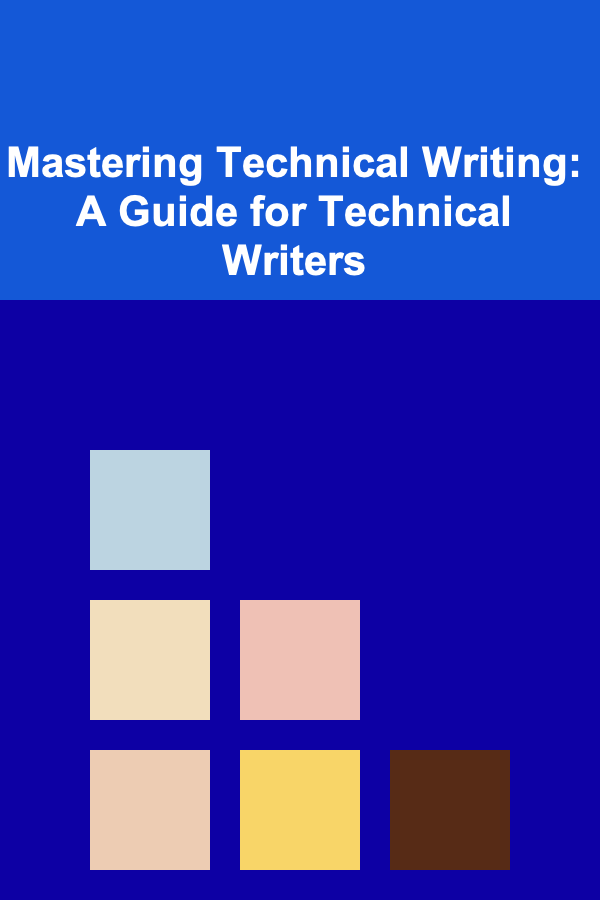
Mastering Technical Writing: A Guide for Technical Writers
ebook include PDF & Audio bundle (Micro Guide)
$12.99$11.99
Limited Time Offer! Order within the next:

Technical writing is a specialized form of communication that involves conveying complex information in a clear, concise, and easy-to-understand manner. Whether you're writing user manuals, API documentation, product specifications, or white papers, mastering technical writing is essential for ensuring your audience grasps the information effectively. This guide aims to provide actionable insights, tips, and strategies to help you elevate your technical writing skills and create exceptional documents.
Understanding the Role of a Technical Writer
Before diving into the techniques, it's important to understand the role of a technical writer. A technical writer's job is not just about writing; it's about translating complex concepts into understandable content. This involves:
- Researching: Gathering the necessary information from subject matter experts (SMEs), technical documentation, and practical use cases.
- Synthesizing: Organizing and simplifying complex data into structured, easily digestible content.
- Communicating: Writing clearly and concisely to ensure the target audience can follow instructions, understand concepts, and solve problems.
- Testing: Reviewing content in real-world scenarios to ensure that it works and is accurate.
Technical writers act as the bridge between technical experts and non-technical users, ensuring that information is both accessible and accurate.
Essential Skills for Technical Writers
While anyone can write, technical writing requires a specific skill set that differentiates exceptional writers from average ones. Here are the essential skills you need to master:
1. Clarity and Conciseness
Clarity is the cornerstone of good technical writing. Your job is to remove ambiguity and present information in the simplest form possible. This requires avoiding jargon or, when necessary, explaining technical terms clearly.
- Avoid wordiness: Stick to the point and only include what's necessary.
- Use simple language: Your goal is to make the document understandable for users, so avoid unnecessary complexity.
2. Audience Awareness
Understanding the audience is a crucial skill for a technical writer. The way you write will vary depending on whether you're addressing experts in a field or novices. It's essential to tailor your writing to the knowledge level, needs, and preferences of your readers.
- Beginner-level audience: Simplify technical concepts and provide background information.
- Expert-level audience: Focus on precise, in-depth details and use industry-specific terminology.
3. Organizational Skills
Technical writing involves creating structured documents, which often require complex hierarchies of information. You must organize content in a way that's easy for the reader to follow.
- Use clear headings and subheadings: Organize content logically, with a clear progression of ideas.
- Create an intuitive structure: Break the content into sections such as introduction, instructions, and troubleshooting, and ensure each section has a clear purpose.
4. Attention to Detail
Accuracy is vital in technical writing. A single mistake could lead to misinterpretation or even cause users to make errors. Therefore, a sharp eye for detail is necessary to ensure that every piece of information is correct, especially when dealing with instructions or specifications.
- Fact-checking: Always verify technical data with SMEs or reliable sources before publishing.
- Consistent terminology: Ensure that terms are used consistently across the document to avoid confusion.
5. Research Skills
Technical writers often work with new technologies, concepts, or processes. Conducting thorough research is essential to ensure you're conveying the most accurate and up-to-date information.
- Use credible sources: Refer to official documentation, industry standards, or expert opinions.
- Interview subject matter experts (SMEs): Communicate with engineers, developers, or designers to get firsthand insights into the technical aspects of the product or service.
6. Technical Proficiency
While you don't necessarily need to be an expert in every technical field you write about, a basic understanding of the technology or industry will greatly enhance your ability to write accurately. Familiarity with the tools and platforms your audience uses, such as software or hardware, helps create more relevant and useful content.
- Learn basic programming languages or technical concepts: If you're writing API documentation, for instance, understanding basic programming concepts is crucial.
- Use technical tools effectively: Familiarize yourself with tools like markdown, LaTeX, and DITA for technical document formatting.
Actionable Strategies for Improving Your Technical Writing
Now that we've covered the core skills needed to succeed as a technical writer, let's dive into actionable strategies to improve your writing.
1. Master the Art of Instructional Writing
Many technical writing tasks involve providing instructions or guidance. Whether you're writing a user manual or software documentation, the ability to break down complex tasks into simple steps is critical.
Tips for Instructional Writing:
- Use numbered lists for step-by-step processes: This allows readers to follow along easily.
- Use clear, direct verbs: Opt for active verbs that instruct readers to perform specific actions. For example, "Click" instead of "The user should click."
- Include visuals when possible: Diagrams, screenshots, or videos can significantly enhance understanding, especially for complex steps.
2. Follow the "Show, Don't Tell" Principle
In technical writing, this principle means demonstrating how something works rather than just explaining it. If you're writing about a software feature, for instance, show the user how to use it with an example, rather than just describing it.
- Provide examples: Use real-world examples to illustrate how technical concepts are applied.
- Use code snippets (when applicable): For software documentation, showing the code snippet directly can make concepts clearer.
3. Use Consistent Formatting and Style Guidelines
Adhering to a consistent style guide is essential for technical writing. Whether you're working independently or as part of a larger team, having a unified set of rules for punctuation, capitalization, terminology, and more helps maintain consistency.
Establishing Formatting Guidelines:
- Use consistent headings: Decide on a standard format for headings and subheadings (e.g., use Title Case for all section headers).
- Use bulleted and numbered lists appropriately: Bulleted lists work for unordered items, while numbered lists are perfect for step-by-step instructions.
- Maintain consistent terminology: Ensure that you use terms like "login" and "log in" correctly and consistently.
If your company or team doesn't have a style guide, consider creating one or adopting existing guides such as The Microsoft Manual of Style or The Chicago Manual of Style.
4. Focus on User-Centered Writing
Your goal is to make your writing as user-friendly as possible. Always keep the reader's needs at the forefront of your writing process. Anticipate the questions or difficulties they may face while reading and try to address those upfront.
Tips for User-Centered Writing:
- Write with empathy: Understand your reader's perspective, challenges, and needs.
- Avoid passive voice: Passive voice can make sentences convoluted and harder to understand. Aim for an active voice that clearly assigns actions to the subject.
- Make it skimmable: Users often skim technical documents, so break your text into smaller sections with subheadings, bulleted lists, and bolded keywords for easy navigation.
5. Collaborate with Other Teams
Collaborating with other teams---such as engineers, designers, or product managers---can provide invaluable insights and improve the quality of your documentation. Technical writers who interact with the product development process are better equipped to create accurate, up-to-date documentation.
How to Collaborate Effectively:
- Participate in design or development sprints: This helps you understand how features evolve and lets you update the documentation accordingly.
- Request feedback on drafts: Ask SMEs to review your drafts for technical accuracy.
- Understand user pain points: By interacting with customer support or QA teams, you can address common user issues in your documentation.
6. Maintain a Continuous Learning Mindset
The field of technical writing is constantly evolving, especially with the rise of new technologies and tools. To remain competitive, it's important to continuously improve your skills.
- Stay updated with industry trends: Follow blogs, attend conferences, and participate in forums to stay abreast of new tools and techniques.
- Take courses: Consider enrolling in courses on technical writing, content management, or even coding if relevant to your work.
Conclusion
Mastering technical writing is an ongoing process of learning and refining your skills. By focusing on clarity, audience understanding, organization, and continuous improvement, you can create documents that effectively communicate technical information to diverse audiences. Remember that the goal of technical writing is to simplify complex information, making it accessible to those who need it. Through practice, collaboration, and attention to detail, you'll become a proficient and impactful technical writer capable of tackling any challenge that comes your way.

Mastering the Art of Coupon Codes: Boost Your Savings with These Simple Tricks
Read More
Voice Acting Mastery: Mastering Emotion, Style, and Performance in Voiceovers
Read More
How To Improve Your Presentation Skills
Read More
How to Develop Your Critical Thinking Skills
Read More
10 Tips for Maximizing Retirement Savings Contributions
Read More
10 Tips for Mastering SQL for Business Intelligence
Read MoreOther Products

Mastering the Art of Coupon Codes: Boost Your Savings with These Simple Tricks
Read More
Voice Acting Mastery: Mastering Emotion, Style, and Performance in Voiceovers
Read More
How To Improve Your Presentation Skills
Read More
How to Develop Your Critical Thinking Skills
Read More
10 Tips for Maximizing Retirement Savings Contributions
Read More